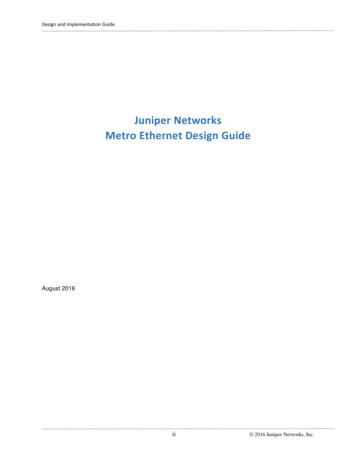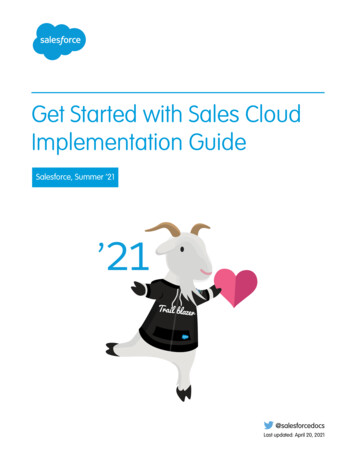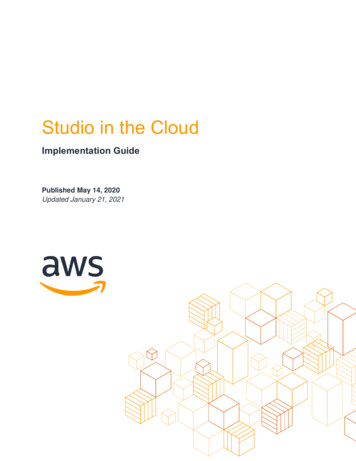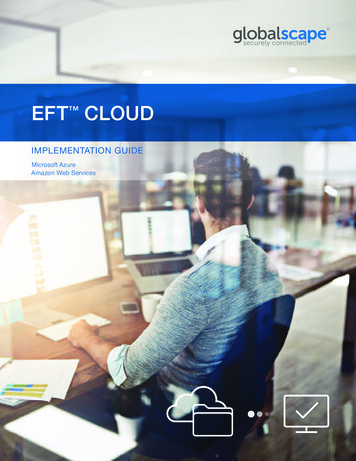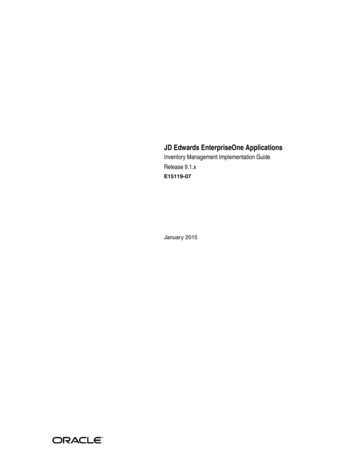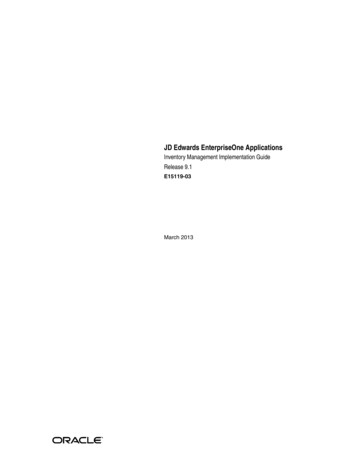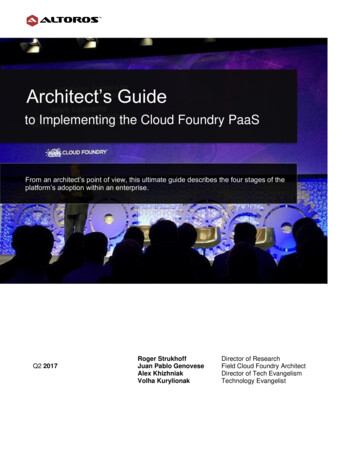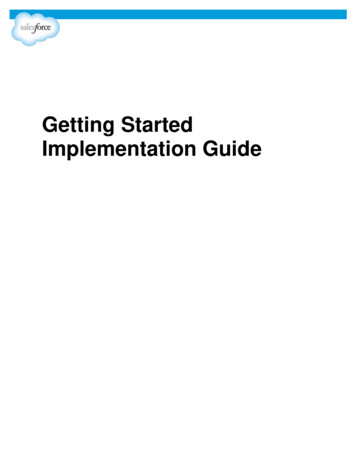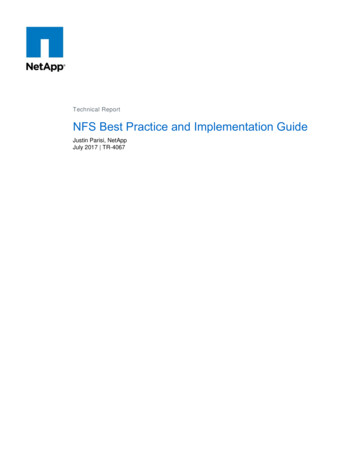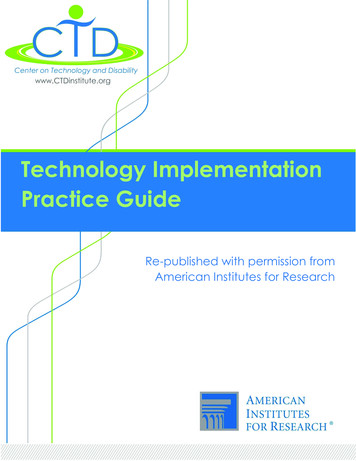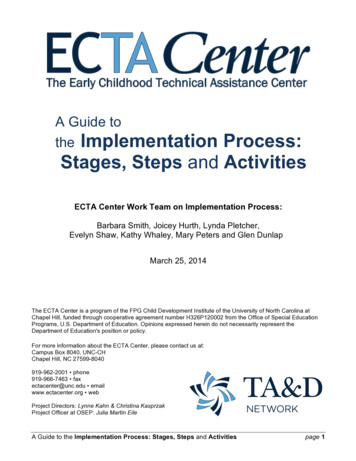
Transcription
A Guide tothe ImplementationProcess:Stages, Steps and ActivitiesECTA Center Work Team on Implementation Process:Barbara Smith, Joicey Hurth, Lynda Pletcher,Evelyn Shaw, Kathy Whaley, Mary Peters and Glen DunlapMarch 25, 2014The ECTA Center is a program of the FPG Child Development Institute of the University of North Carolina atChapel Hill, funded through cooperative agreement number H326P120002 from the Office of Special EducationPrograms, U.S. Department of Education. Opinions expressed herein do not necessarily represent theDepartment of Education's position or policy.For more information about the ECTA Center, please contact us at:Campus Box 8040, UNC-CHChapel Hill, NC 27599-8040919-962-2001 phone919-966-7463 faxectacenter@unc.edu emailwww.ectacenter.org webProject Directors: Lynne Kahn & Christina KasprzakProject Officer at OSEP: Julia Martin EileA Guide to the Implementation Process: Stages, Steps and Activitiespage 1
A Guide tothe ImplementationProcess:Stages, Steps and ActivitiesTable of ContentsIntroduction . 4Planning for Change . 6Stage 1: Exploration . 7Step 1: Establish a State Leadership Team (SLT) to guide exploration . 7Step 2: The SLT convenes a stakeholder group for needs assessmentand system analysis . 7Step 3: Stakeholders explore the feasibility and "fit" of potential innovationsand practices . 8Step 4: The SLT decides on practices/innovation and whether or not to proceed . 8Step 5: The SLT secures agency and cross-agency leadership support . 8Outcomes of Exploration . 8Stage 2: Installation . 9Step 1: The SLT finalizes membership and responsibilities . 9Step 2: The SLT develops a communication plan for statewidebuy-in . 9Step 3: The SLT establishes Implementation Sites and Teams . 9Step 4: The SLT develops system supports and infrastructure changes . 10Step 5: The SLT improves data systems, evaluation and monitoring . 10Step 6: The SLT builds Training and Technical Assistance (T&TA) capacity;begins training . 10Step 7: The SLT finalizes a written plan . 10Outcomes of Installation. 10A Guide to the Implementation Process: Stages, Steps and Activitiespage 2
Stage 3: Initial Implementation . 11Step 1: State TA providers train and coach Implementation Site personnel . 11Step 2: Implementation teams support practitioners and monitor the use ofnew practices . 11Step 3: The SLT and Implementation Teams use feedback loops andimprovement cycles to adjust organizational supports. 11Step 4: The SLT and Implementation Teams evaluate fidelity, andemerging outcomes. 12Outcomes of Initial Implementation . 12Stage 4: Full Implementation . 12Step 1: Site Implementation Teams maintain T&TA supports . 12Step 2: The SLT and Implementation Teams ensure that data systems, policies,procedures and funding are integrated and functioning . 13Step 3: Implementation Teams regularly use performance assessment . 13Step 4: The SLT and Implementation Teams use feedback and data tosustain fidelity. 13Step 5: The SLT and Site Implementation Teams ensure on-going sustainability ofstructures and practices . 13Outcomes of Full Implementation . 13Stage 5: Expansion/Scale-up . 14Step 1: Initial Implementation Sites assist the SLT in expansion . 14Step 2: The SLT selects new sites and provides necessary supports . 14Step 3: New sites begin their implementation process . 14Step 4: The SLT establishes mechanisms for sustaining fidelity of practices . 15Outcomes of Expansion and Scale-up . 15A Guide to the Implementation Process: Stages, Steps and Activitiespage 3
A Guide tothe ImplementationProcess:Stages, Steps and ActivitiesIntroduction“Implementation: The process of moving an idea from concept to reality”(Webster’s Collegiate Dictionary)Improving child and family outcomes is a cornerstone of early childhood education and in particularthe IDEA Part C and Part B, Section 619 Preschool programs. To improve outcomes, an evidencebased practice or innovation must be selected and the process of implementing that practice orinnovation must be effective. Implementation science is the study of the processes needed to bringnew practices into widespread use.Changing policies or guidelines, providing information and training alone are not adequate to bringabout sustainable changes in practice. To adopt evidence-based practices, the implementationprocess must also address the organizational supports which are necessary to initiate and sustainthe practices with fidelity. Through carefully planned implementation, the adoption of any newpractices builds the system’s capacity for change.The stages described in the guide include: 1) exploration, 2) installation, 3) initial implementation, 4)full implementation, and 5) expansion and scale-up. Each stage has specific steps and associatedactivities. While the stages, steps and activities suggest a linear sequence of events, in actualimplementation there is often a more dynamic flow to the work. Some stages or steps may beoccurring simultaneously and the work often circles back to revisit earlier stages. Implementationdrivers such as technical leadership and adaptive leadership, organizational supports andpersonnel development mechanisms must align with and support the new practices.This guide is based on a review of the literature of implementation science (Fixsen, Naoom, Blase,Friedman, & Wallace, 2005) and the collective experiences of federally funded national centers inconducting state-wide system change initiatives. These centers include the National EarlyChildhood Technical Assistance Center (NECTAC, now the ECTA Center), Technical AssistanceCenter on Social Emotional Intervention for Young Children (TACSEI), Center on the Social andEmotional Foundations for Early Learning (CSEFEL), National Implementation Research Network(NIRN) and the State Implementation of Scaling-Up Evidence-based Practices (SISEP).Note: Implementation science terminology used in the document is defined in an online glossary. Allglossary terms are highlighted and linked to this glossary the first time used.An online version of this guide and glossary are available ementprocess.aspA Guide to the Implementation Process: Stages, Steps and Activitiespage 4
ReferencesFixsen, D.L., Naoom, S.F., Blase, K.A., Friedman, R.M., & Wallace, F. (2005). Implementationresearch: A synthesis of the literature. Tampa, FL: University of South Florida, Louis de la ParteFlorida Mental Health Institute, The National Implementation Research Network (FMHI Publication231). Downloadable at es/resources/NIRNMonographFull-01-2005.pdfHalle, T., Metz, A. & Martinez-Beck, I. (Eds.), (2013). Applying implementation science in earlychildhood programs and systems. Baltimore, MD: Paul H. Brookes Publishing Company.Metz, A. & Bartley, L. (2013). Active implementation frameworks for program success: How to useimplementation science to improve outcomes for children. Zero to Three, March 2012.National Centers ECTA Center http://ectacenter.org/Center on the Social and Emotional Foundations for Early Learning (CSEFEL)http://csefel.vanderbilt.edu/National Implementation Research Network (NIRN) http://nirn.fpg.unc.edu/State Implementation of Scaling-Up Evidence-based Practices (SISEP) http://sisep.fpg.unc.edu/Technical Assistance Center on Social Emotional Intervention for Young Children (TACSEI)http://www.challengingbehavior.org/A Guide to the Implementation Process: Stages, Steps and Activitiespage 5
Planning for ChangeChange is complex and dynamic. It involves moving or transforming from something familiar tosomething new. Change can be broad, affecting multiple practices or aspects of the program, or itmight be narrow, affecting fewer practices. Regardless of the scale, change is a dynamic active andon-going process, rather than a single event.There are many reasons for programs or agencies to engage in a change process. Some of thesemay include: A newly defined vision or directionA crisisA new mandateData that supports a change is neededNew information and/or researchOld ways are not getting the needed or desired outcomesNew leadership bringing different practicesThe push to change can come from any level of the organization. Regardless of where the initialpush comes from, it is essential that a change effort is carefully planned. It is important thatprogram and agency leaders first examine the current organizational and political climate to assessreadiness to both begin and sustain implementation and scaling up (or expansion) of new practicesor an innovation.This examination should include: Identification of key stakeholders who share the interest and need for changeAssessment of the degree to which these stakeholders perceive the issue or need to be apriorityWillingness of leadership from multiple agencies and programs to support the change processover a period of timeIdentification of a leadership team responsible for the oversight of necessary aspects of thechange process over timeDesire to engage in discussions and gather information about potential solutions to identifiedneedsKnowledge of implementation science and its application to the change processIt is important to recognize that, planning and engaging in the implementation of any newinnovation, evidence-based practice, or cluster of practices takes time, energy and resources. Thechange process can be understood and organized using defined steps and subsequent activitiesthat are needed to move a concept into reality. These steps and activities are outlined in thefollowing document, "A Guide to the Implementation Process: Stages, Steps and Activities".A Guide to the Implementation Process: Stages, Steps and Activitiespage 6
Stage 1: ExplorationThe goals of the exploration stage are to identify the need for change, determine what innovation orset of practices are likely to meet that need, and to decide whether or not to move ahead with theimplementation process. This stage, and all other stages, are guided by a State Leadership Team.The State Leadership Team (SLT) should include cross- sector representation of agencies andprograms impacted by the proposed initiative. The composition, vision and mission of this initialteam may change over time as they go through the stages and steps.The SLT ensures that the perspectives of key stakeholders from every level of the service systemare included as a part of a needs assessment of the current service delivery system. All availabledata describing current challenges and need for change should be gathered and shared withstakeholders. Stakeholders help build a common understanding of the current status and thedesired changes in practices and outcomes. They are included in exploring potential practices orinnovations to determine how well they fit with the mission, values, desired outcomes and resourcesof the agency/program.During the exploration stage, an important consideration for the State Leadership Team is whetherthey can commit to a multi-year implementation process. If the decision is to proceed withimplementation, then building public awareness and widespread support for the change is crucial.Step 1: Establish a State Leadership Team (SLT) to guide explorationa. Include representatives from each of the key agencies/programs with the authority tomake decisions and expend resources (or an individual with easy access to thatdecision-maker).b. Select staff whose responsibilities will allow them to undertake this initiative over severalyears and.c. Select staff with expertise about the implementation process as well as potentialinnovations or practices that fit identified needs.d. SLT defines their roles and responsibilities.Step 2: The SLT convenes a stakeholder group for need
practices builds the system’s capacity for change. The stages described in the guide include: 1) exploration, 2) installation, 3) initial implementation, 4) full implementation, and 5) expansion and scale-up. Each stage has specific steps and associated activities. While the stages, steps and activities suggest a linear sequence of events, in actual implementation there is often a more .

